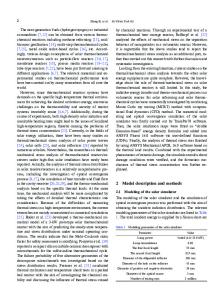Blocking analysis of thermal runaway of a lithium-ion battery under local high temperature based on the material stabili
- PDF / 3,914,171 Bytes
- 16 Pages / 595.276 x 790.866 pts Page_size
- 4 Downloads / 256 Views
ORIGINAL PAPER
Blocking analysis of thermal runaway of a lithium-ion battery under local high temperature based on the material stability and heat dissipation coefficient Xudong Sun 1 & Xiaoming Xu 2 & Lijin Zhao 1 & Huifen Jin 3 & Lingdi Cao 3 & Hongmei Wang 3 Received: 20 July 2020 / Accepted: 1 October 2020 # Springer-Verlag GmbH Germany, part of Springer Nature 2020
Abstract In order to achieve a safer battery and battery design, it is necessary to fully understand thermal runaway. In this paper, the thermal abuse model of the NCM lithium-ion battery is established. Through simulation analysis, the thermal runaway characteristics of lithium-ion batteries under different heat dissipation conditions and different thermal stability materials were obtained, including the values of initial temperature and maximum temperature and time. The results show that improving the heat dissipation condition outside the battery can improve the heat transfer coefficient of the battery surface, reduce the rising speed of the battery temperature, and delay the time and heat of the heat generation side reaction. When the local temperature is 200 °C, the coefficient of heat transfer is greater than 1 W/(m2 K), and in the positive reaction with electrolyte initial temperature of 210 °C, the battery will not undergo the heat out of control. Keywords Lithium-ion battery . Local heat source . Thermal runaway . Material stability . Heat dissipation coefficient
Introduction Since the twenty-first century, as environmental pollution problems and resource scarcity have intensified, the development of green energy is an inevitable trend. The automotive industry is also ushered in electrification, and lithium-ion batteries are important parts of the power system for electric vehicles and hybrid electric vehicles [1–3]. Lithium-ion batteries have the advantages of high energy density, long cycle life, low self-discharge rate, and low pollution, which have become the main power source for electric vehicles [4–8]. However, thermal runaway is one of the greatest potential safety hazards affecting the application of lithium-ion batteries [9–12]. Lithium-ion batteries generate a lot of heat and gas when thermal runaway undergoes, and even fire and
* Xiaoming Xu [email protected] 1
China Society of Automotive Engineers, Beijing 100176, China
2
School of Mechanical Engineering, University of Science and Technology Beijing, Beijing 100083, China
3
TianJin Lishen Battery Joint-Stock CO., LTD., Tianjin 300384, China
explosion occur in severe cases. NCM (LiNixMnyCo1-x-yO2) lithium-ion batteries have more active battery materials, and they have higher energy density and worse thermal stability, which means that they are more likely to enter thermal runaway. Therefore, an in-depth study of the development law and influencing factors of NCM lithium-ion battery thermal runaway is a necessary prerequisite for ensuring the safe operation of electric vehicles [13, 14]. According to the trigger mode of thermal runaway of lithium-ion batteries, the
Data Loading...











